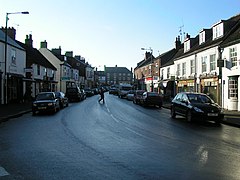Boroughbridge
| Boroughbridge | ||
|---|---|---|
| Coordinates | 54 ° 6 ′ N , 1 ° 24 ′ W | |
| OS National Grid | SE393668 | |
|
|
||
| Residents | 3201 (as of: 2001) | |
| administration | ||
| Post town | YORK | |
| ZIP code section | YO51 | |
| prefix | 01423 | |
| Part of the country | England | |
| region | Yorkshire and the Humber | |
| Shire county | North Yorkshire | |
| District | Harrogate | |
| Civil Parish | Boroughbridge | |
| British Parliament | Harrogate & Knaresborough | |
| Website: website | ||
Boroughbridge is a hamlet and a Civil parish in the Borough of Harrogate in North Yorkshire , England . Boroughbridge was originally a parish in the Traditional County of West Riding of Yorkshire in England.
Boroughbridge is located 21 km northwest of York on the A1 road - but not directly since the bypass. Here the A1 crosses the River Ure . Aldborough , the former Roman Isurium Brigantum, is right next to the village .
There is a primary school in town and Boroughbridge High School , which specializes in the performing arts.
Surname
When the course of Dere Street was relocated there after the Norman conquest of England because of the new bridge over the River Ure at Boroughbridge , the original river crossing at Aldborough lost its importance. A new town grew on the bridge, which was named New Borough on t'Brigg , Borough on t'Brigg and finally Boroughbridge, while the older town was now called Ald-Borough . The Dere Street was a Roman road connecting Eboracum (now York) to Veluniate the Antonine Wall (today Bo'ness in Scotland ). It was later called the Great North Road and is now part of the A1.
history
A 170 m long row of stones, called Devil's Arrows , stands just 200 m east of the A1 in the west of Boroughbridge. It consists of three menhirs , the remainder of a settlement originally consisting of other stones and probably dates from the late Neolithic (5500 to 2200 BC) or the early Bronze Age (2200 to 1600 BC). A visitor described a series of seven stones in 1694, John Leyland (1506–1552) named only four. The missing fourth stone is said to have been crushed as building material for the Peg Bridge over the River Tutt .
On the famous medieval map of Britain by Matthew Paris , created around 1250, Boroughbridge is named as one of the most important cities of the time.
The battle of Boroughbridge on March 16, 1322 between the troops of King Edward II and those of the insurgent barons under Thomas Plantagenet, 2nd Earl of Lancaster, ended with a victory for the royalists over the rebels.
From 1558 to 1832 the parish had two MPs, whom it lost under the Reform Act 1832 . The best known of them were General Henry Clinton , who had long been held responsible for the loss of the American colonies , and Augustus FitzRoy, 3rd Duke of Grafton (1735-1811), Minister and from 1768 to 1771 Prime Minister under King George III .
traffic
Boroughbridge was an important coaching inn on the Great North Road between London and Edinburgh .
In 1945 the A1 bridge over the River Ure collapsed under the heavy transport of an 80-ton blast furnace and was replaced by a Bailey bridge by pioneers in the British Army until it was restored .
The station of the Pilmoor, Boroughbridge and Knaresborough Railway in Boroughbridge, which was closed in 1964, can only be recognized by the double water tower of the depot, an industrial monument.
Picture gallery
Web links
- Community website (accessed November 11, 2013)
- History and further information (accessed November 11, 2013)
- City guide (accessed November 11, 2013)
Individual evidence
- ↑ Edmund Bogg: Richmondshire and the Vale Of Mowbray , Elliot Stock 1908, Vol. 1, pp. 8-12.






